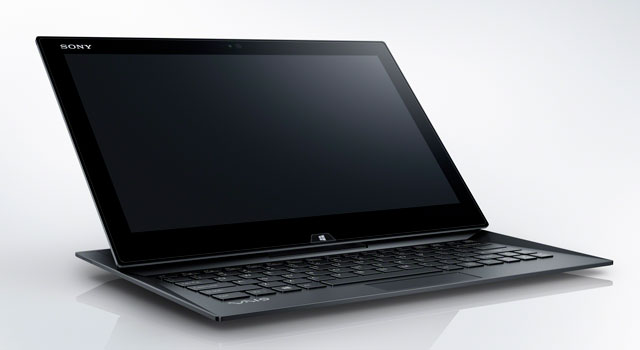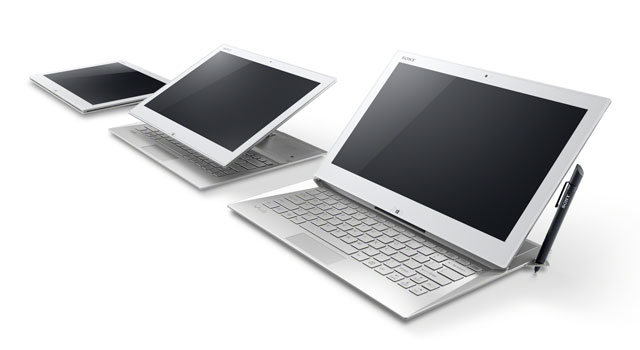
It’s often the case that the bigger and more successful the company, the more difficult it is to innovate because of the number of conflicting agendas at play. The creative team may be wanting to push boundaries, but with executives watching the bottom line, left-field ideas often live and die on the drawing board. Sony, it seems, has given its design department a budget and free rein. The result is the Sony Vaio Duo 13.
Somewhere between a tablet computer and a laptop, the Duo 13 isn’t the first time Sony’s tried the “convertible” form factor that takes a touch display — which looks at first like a thick and heavy tablet — that slides up to reveal a full keyboard and trackpad.
It tried it recently with a smaller model, the Duo 11. By all accounts, the Duo 11 wasn’t a big success, mainly because of limited battery life and a too tightly packed keyboard. Enter the Duo 13, with larger body, display and battery.
Sony’s kept the fantastic 13-inch 1080p display in the new Vaio Pro 13 and, although touch was optional on the Pro, it’s understandably standard issue on both the “consumer” and “professional” models of the Duo. It’s not just the resolution that makes the display so appealing; colours are bright and saturated, the contrast ratio is high, and the viewing angles are excellent.
In addition to touch input, Sony also includes a stylus with the Duo range. Resembling a high-end ballpoint pen, it has two physical buttons and the Duo 13 recognises when you’re using it so that resting your palm on the screen doesn’t register as input. There’s no discernable lag when using the stylus and it allows for incredible precision compared to touch input, particularly in light of its pressure sensitivity.
Slate mode
When in slate mode, the Duo is brought to life by pushing the Windows button centred in the bezel below the display, or by sliding the display up to reveal the keyboard and trackpad. The keyboard is an absolute delight to use, with low-profile, nearly silent Chiclet-style keys devoid of the spacing problems that plagued the Duo 11.
The trackpad, on the other hand, is too small, leading to frustration. Thankfully, the touch display renders the trackpad largely unnecessary, but one wonders why it wasn’t done away with entirely.

The top-end Duo 13, which we reviewed, includes an energy-sipping Haswell Intel Core i7 processor and 8GB of RAM, along with 256GB of flash storage, making it sufficiently potent for anything we could throw at it. All ports are housed on the rear of the device and include a pair of USB 3 ports, a full-sized HDMI port, an audio jack and a card reader.
Because of its tablet credentials, the Duo 13 also includes both front- and rear-facing cameras — 2,1-megapixel and 8-megapixel models respectively. Given the size and weight of the device, the rear camera seems like something most people will seldom use.
For all its cleverness, there are a still a few fundamental problems with the design of the Duo 13. For starters, the screen can only ever be set to one angle when you want to use the keyboard — somewhere between 45 and 50 degrees. That’s perfect when its on your lap, but less so on a desk, and simply impractical if you use your laptop to consume video, something the Duo’s HD display is perfectly suited to.
Similarly, the volume controls sit on the underside of the device, next to the largely superfluous “assist” button that brings up Sony’s built-in help interface.
Finally, as sturdy and well made as the Duo feels, we can’t help but wonder about the practicality of a complex hinge system on a device likely to be used heavily, or the fact that the screen is always exposed because it faces outwards, as opposed to closing against the keys like a traditional laptop.
Like the Vaio Pro 13, the Duo 13 should deliver at least six hours of use with brightness turned fairly high and Wi-Fi on. That’s not in the same league as Apple’s refreshed MacBook Airs, but then those don’t have nearly the same resolution or touch capabilities the Duo offers.

Gripes aside, the Duo 13 is a stunning device. Its stereo speakers provide excellent sound (by laptop standards), it feels high end without weighing a ton, and it’s certain to get the attention of other digital nomads in your local coffee shop.
However, it still feels like something of an experiment, and while we’re all in favour of companies pushing the envelope when it comes to design, we’re not sure we’d be ready to spend the sort of cash required to participate as a test subject.
Sony is to be commended for the chances it’s taken with the Duo 13. Given its price, it probably won’t sell anywhere as well as the Japanese company would like, but it bodes well for the future releases from a company that’s done an incredible about-turn in recent years and shown itself capable of releasing outstanding phones, tablets and ultraportable laptops.
At R22 999 for the “professional” Duo 13 — the model we were supplied for review — and R16 999 for the “consumer” version, it’s tough to recommend over Sony’s own Vaio Pro range or Apple’s MacBooks, but then, those are different devices. The Duo is an unconventional product aimed at consumers looking for something unique.
We can only imagine the target market Sony has in mind consists of designers, illustrators, architects or those who want a device that attracts attention. The good news is, they’re all going to love it. — (c) 2013 NewsCentral Media

